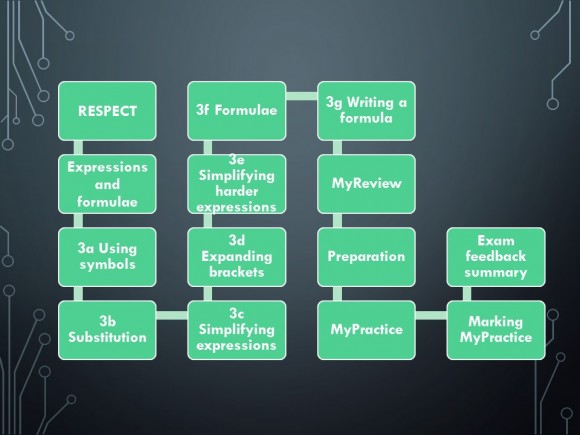A new term, a new unit – expressions and formulae. What am I expecting the students to know already? What knowledge will I be checking for in the first couple of lessons. Students should already know how to…
- Use basic algebraic notation (some awareness)
- Carry out arithmetic operations in the correct order (not yet)
- Extract information from a written description – for some of our students the literacy is more challenging than the maths.
The chapter starts by revising algebraic notation (the use of a letter to stand for an unknown number) and then completing simple substitutions. Collecting like terms, expanding a single bracket and slightly harder simplifications are covered followed by evaluating and creating simple formulae. Does that sound all a little foreign? To help both students and parents and carers, I have already set the following sessions on MyMaths; Rules and formulae 1158, Simplifying 2 1178, Simplifying 1 1179, Substitution 1 1187 , Single brackets 1247 and these are recorded in the student planners.
Algebra is the language mathematicians use to write down general statements that can apply to one or more numbers.
If Joe is x years old now, how old will he be in 6 years’ time? (x + 6)
We will substitute numerical values into formulae and expressions, including scientific formulae. This is the type of maths you use when calculating cooking times for your Sunday roast, For example 20 min per kilogram + 30 minutes. Getting your child to help you calculate the cooking times for your Sunday roast would help me? Or call out charges for a plumber, £40 call out and then £30 per hour. I know, where could you find such a reasonably priced plumber?
Formulae tell you what one thing equals, given the value of another arbitrary quantity. We will be using and interpreting algebraic notation, for example ab in place of a × b and 3y in place of y + y + y and 3 × y. An expression is a sentence that uses symbols and numbers. It contains letters but no equals sign. For example, the “total cost” as a function of the number of “items sold.” Learning how to write and manipulate algebraic expressions allows you to solve more complex problems. Towards the end of the unit we will simplify and manipulate algebraic expressions and hopefully model situations by translating them into algebraic expressions or formulae and by using graphs. Depending on how deep we go…
Maths literacy; expressions, equations, inequalities, unknown, terms and factor are just a handful of key maths literacy terms we will cover.
Of course we will still be working on our multiplication tables and Timetable Rock stars. Of course we will be undertaking a short mid term MyPractice paper and of course, each student will get their personalized feedback summary.
Sorry to harp on about personalize organization, being prepared (pens and rulers) are still frequent reminders for the minority. A handful of students did not complete the set MyMaths tasks last term. This was raised with the four students concerned and they will be asked to complete these during their break times. I will leave a note in planners if you wish to know if this applies to your son or daughter. Thank you to those families that took the time to make and photograph your half term holiday pancakes, they looked impressive, house points have been awarded.



